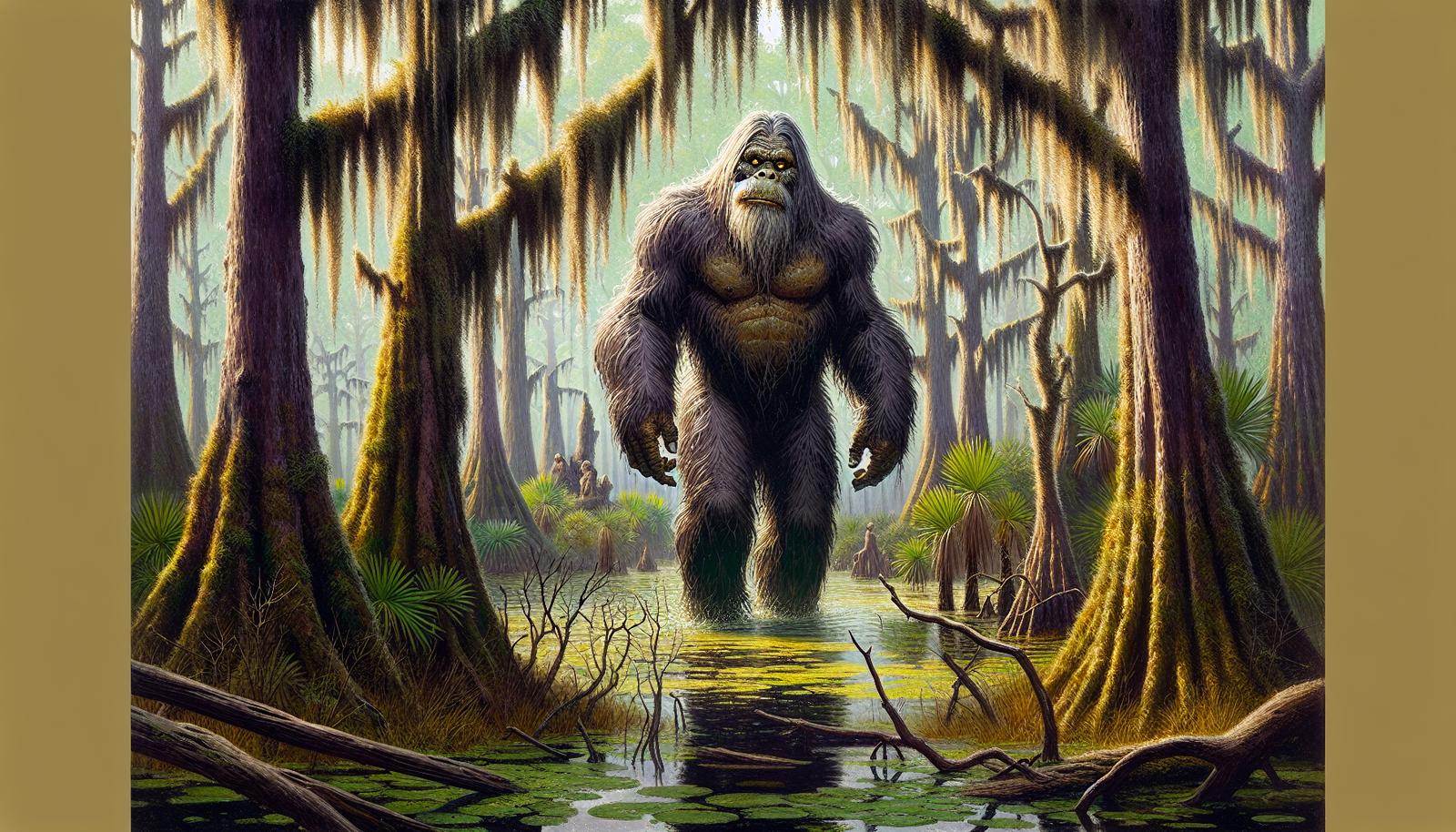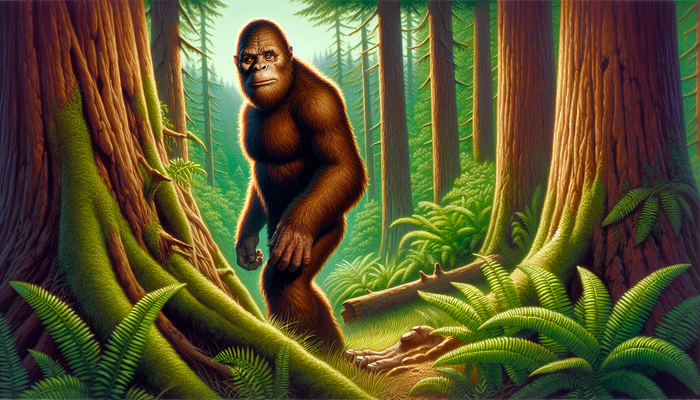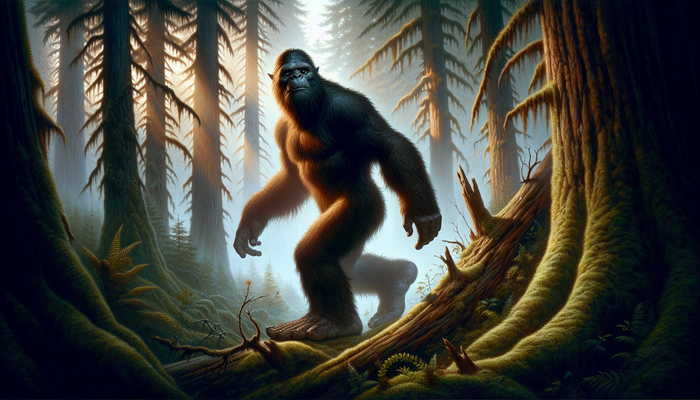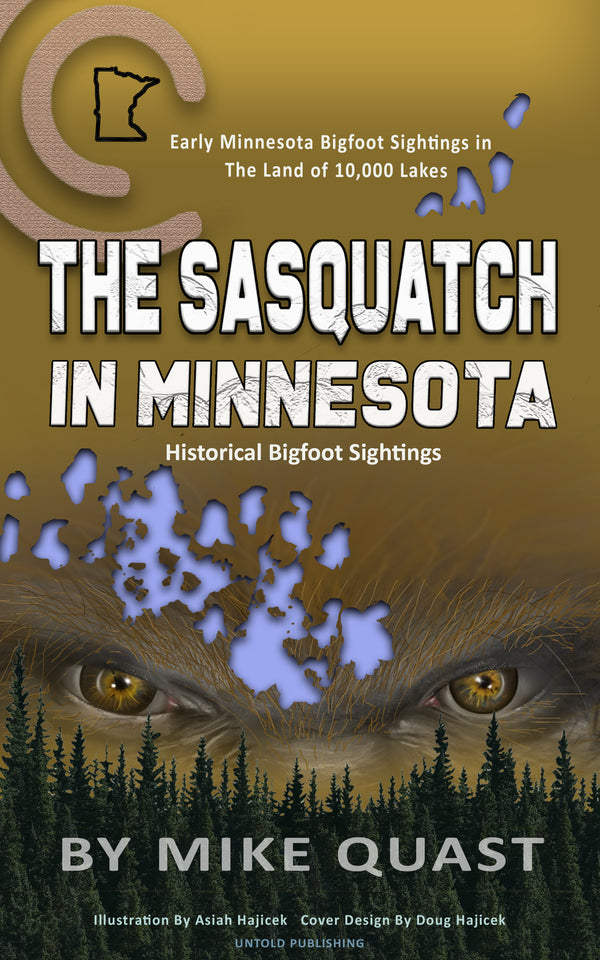Louisiana Bigfoot: A Cryptid's Enduring Legacy

By Jack Sullivan, Cryptozoologist
In the heart of the bayou, where Spanish moss drapes from ancient cypress trees and the murky waters conceal untold secrets, a legend has persisted for generations. The Louisiana Bigfoot, also known as the Skunk Ape or Honey Island Swamp Monster, has captured the imagination of locals and cryptozoology enthusiasts alike. This elusive, hairy hominid has left an indelible mark on the state's folklore, with a rich history of sightings and encounters that span over a century. As a dedicated researcher, I have delved deep into the archives and ventured into the swamps to uncover the truth behind this enduring mystery. Join me on a journey through time and terrain as we explore the fascinating world of the Louisiana Bigfoot and its place in the annals of cryptozoological lore.
Early Sightings and Historical Context
The tale of the Louisiana Bigfoot begins in the mid-19th century, when a central Louisiana newspaper published a captivating account of a "tall, wild man covered in hair" roaming the wilderness. This 1850 report marked the first documented sighting of the creature and set the stage for a long tradition of Bigfoot encounters in the state. As the years passed, sporadic sightings continued to emerge, with eyewitnesses describing a large, bipedal creature covered in dark, shaggy hair. These early accounts, while often met with skepticism, laid the foundation for what would become a cultural phenomenon and a source of endless fascination for generations to come.
The historical context of these sightings is crucial to understanding the significance of the Louisiana Bigfoot legend. In the late 19th and early 20th centuries, the state was still largely rural and undeveloped, with vast expanses of untamed wilderness. The dense forests, swamps, and bayous provided an ideal habitat for a creature of myth and mystery to thrive, hidden from the prying eyes of civilization. As tales of the Bigfoot spread through local communities, they became intertwined with the rich tapestry of Cajun and Native American folklore, adding layers of intrigue and symbolism to the legend.
The 1970s: A Pivotal Decade for Louisiana Bigfoot Sightings
The 1970s marked a turning point in the history of the Louisiana Bigfoot, with a series of high-profile sightings that thrust the creature into the national spotlight. In 1972, the small town of Louisiana, Missouri, found itself at the center of a media frenzy when numerous residents reported encountering a large, hairy, foul-smelling creature. This event, known as the "MoMo" incident, sparked a wave of public fascination and prompted investigations by local authorities and cryptozoology enthusiasts.
Eyewitnesses described the creature as standing around 7 feet tall, with a muscular build and dark, matted hair covering its body. The sightings were often accompanied by reports of a pungent, skunk-like odor, leading some to speculate that the creature may have been marking its territory or emitting a defensive scent. The "MoMo" incident garnered national media attention, with newspapers and television networks descending upon the small town to document the strange occurrences.
Around the same time, Louisiana's own Rapides Parish became a hotbed of Bigfoot activity. In the summer of 1972, loggers Earl Whitstine and Carl Dubois claimed to have encountered a 7-foot-tall, black-haired creature while working in the Boggy Bayou area. Their sighting, which was investigated by local authorities and researchers, added to the growing body of evidence suggesting that the Louisiana Bigfoot was more than just a myth.
The impact of the 1970s sightings cannot be overstated. They brought the legend of the Louisiana Bigfoot into the mainstream consciousness and sparked a renewed interest in cryptozoology. Researchers and enthusiasts from across the country flocked to the state, hoping to catch a glimpse of the elusive creature or uncover evidence of its existence. The sightings also prompted a closer examination of the historical accounts, leading to a greater appreciation for the longevity and consistency of the Bigfoot phenomenon in Louisiana.
The Honey Island Swamp Monster: Louisiana's Most Famous Bigfoot
Perhaps no other incarnation of the Louisiana Bigfoot has captured the public's imagination quite like the Honey Island Swamp Monster. This legendary creature first gained notoriety in 1963, when retired air traffic controller Harlan Ford claimed to have encountered a large, bipedal, ape-like being in the dense swamps near Slidell. Ford, along with his friend Billy Mills, described the creature as having gray hair, piercing yellow or red eyes, and an overpowering, foul odor.
The Honey Island Swamp Monster sighting was particularly significant because it was accompanied by the discovery of unusual, three-toed footprints in the soft mud of the swamp. These tracks, which measured around 14 inches in length, were unlike anything Ford or Mills had ever seen before. The distinctive three-toed pattern would become a hallmark of the Louisiana Bigfoot, setting it apart from the more commonly reported five-toed prints found in other regions.
Ford's encounter with the Honey Island Swamp Monster sparked a flurry of interest and investigation. Researchers and cryptozoology enthusiasts descended upon the area, hoping to find additional evidence of the creature's existence. Plaster casts were made of the footprints, and the story of the Honey Island Swamp Monster spread like wildfire through the media and local communities.
The physical description of the Honey Island Swamp Monster, with its unique three-toed prints and pungent odor, has become the archetype for the Louisiana Bigfoot. Many subsequent sightings in the state have reported similar characteristics, leading some researchers to speculate that the Honey Island Swamp Monster may represent a distinct subspecies of Bigfoot, one that has adapted to the unique environment of Louisiana's swamps and bayous.
The legacy of the Honey Island Swamp Monster extends far beyond the initial sighting. It has become a cultural icon, inspiring books, television shows, and even local festivals celebrating the legend. The creature's enduring popularity is a testament to the power of the Bigfoot myth and its ability to capture the imagination of people from all walks of life.
Geographical Distribution of Sightings Across Louisiana
While the Honey Island Swamp Monster may be the most famous example of the Louisiana Bigfoot, sightings of the creature have been reported across the state, from the piney woods of the north to the cypress swamps of the south. This wide geographical distribution suggests that the Bigfoot phenomenon is not limited to a single, isolated area but rather is a part of the larger ecosystem and folklore of Louisiana.
In the northern part of the state, the piney woods of Winn Parish have been the site of numerous Bigfoot encounters. These dense, upland forests provide ample cover and resources for a large, elusive creature to thrive. Sightings in this region often describe a tall, hairy, bipedal figure moving swiftly through the trees, leaving behind broken branches and large, humanoid footprints.
Central Louisiana, particularly the Kisatchie National Forest, has also been a hotspot for Bigfoot activity. This vast wilderness, spanning over 600,000 acres, is characterized by a diverse array of habitats, from longleaf pine forests to hardwood bottomlands. The remote and rugged terrain of the Kisatchie has long been associated with strange, unexplained phenomena, and Bigfoot sightings are no exception. Hunters, hikers, and even forest service personnel have reported encounters with large, hairy, bipedal creatures in the depths of the forest.
Moving westward, the Caddo Lake region, straddling the border between Louisiana and Texas, has a rich history of Bigfoot lore. This unique ecosystem, characterized by its sprawling, cypress-studded lake and surrounding wetlands, has been the site of numerous sightings over the years. The dense, tangled vegetation and labyrinthine waterways of the Caddo Lake region provide an ideal habitat for a creature seeking to avoid detection.
In the central part of the state, the Boggy Bayou area of Rapides Parish has been the focus of intense Bigfoot research and investigation. This low-lying, swampy region, with its dense undergrowth and winding waterways, has been the site of several high-profile sightings, including the aforementioned 1972 encounter by loggers Earl Whitstine and Carl Dubois. The Boggy Bayou area's proximity to the Red River and its tributaries has led some researchers to speculate that the Louisiana Bigfoot may use these waterways as travel corridors, moving between different parts of the state in search of food and shelter.
The diverse ecosystems of Louisiana, from the upland forests of the north to the swamps and bayous of the south, provide a patchwork of habitats that could potentially support a population of Bigfoot creatures. The state's mild climate, abundant water resources, and rich biodiversity would offer ample food sources and cover for a large, omnivorous mammal. Additionally, the remote and often inaccessible nature of many of these areas would allow a creature like Bigfoot to avoid detection and maintain a low profile.
The Atchafalaya Basin: A Bigfoot Hotspot
Of all the regions in Louisiana associated with Bigfoot sightings, none is more compelling or mysterious than the Atchafalaya Basin. This vast, 1.4-million-acre swamp, the largest in the United States, is a labyrinthine network of wetlands, bayous, and hardwood forests that stretches across the southern part of the state. The Atchafalaya is a place of primordial beauty and mystery, where ancient cypress trees tower over dark, still waters, and the calls of countless birds and animals echo through the misty air.
It is in this hauntingly beautiful landscape that many of Louisiana's most intriguing Bigfoot sightings have occurred. For decades, hunters, fishermen, and even petroleum industry workers have reported encounters with large, hairy, bipedal creatures deep within the swamp. These sightings often describe a creature standing 7 to 8 feet tall, with shaggy, dark hair and glowing, yellow eyes. Some witnesses have even claimed to have heard the creature's eerie, howling vocalizations echoing through the night.
The Atchafalaya Basin provides an ideal habitat for a creature like Bigfoot to thrive. The dense vegetation, with its tangled undergrowth and canopy of Spanish moss-draped trees, offers ample cover and concealment. The basin's abundant wildlife, including deer, wild hogs, and countless species of fish and waterfowl, would provide a ready food source for an omnivorous mammal. Additionally, the Atchafalaya's remote and largely inaccessible interior, with its winding waterways and treacherous terrain, would allow a creature like Bigfoot to avoid detection and maintain a low profile.
Researchers and cryptozoology enthusiasts have long been drawn to the Atchafalaya Basin in search of evidence of the Louisiana Bigfoot. Organizations like the Gulf Coast Bigfoot Research Organization (GCBRO) have conducted numerous expeditions into the swamp, collecting eyewitness accounts, making plaster casts of footprints, and even setting up trail cameras in hopes of capturing photographic evidence of the creature.
Despite the challenges posed by the Atchafalaya's harsh and unforgiving environment, researchers remain undaunted in their quest to uncover the truth behind the Louisiana Bigfoot. They point to the consistency and credibility of eyewitness accounts, the discovery of unusual footprints and other physical evidence, and the sheer vastness and remoteness of the swamp as compelling reasons to believe that a large, undiscovered primate could be lurking in its depths.
The Atchafalaya Basin's role as a Bigfoot hotspot has also had a significant impact on the local culture and economy. The legend of the Louisiana Bigfoot has become a part of the region's folklore, with tales of the creature passed down from generation to generation. In recent years, the Bigfoot phenomenon has even become a draw for tourists, with swamp tours and Bigfoot-themed festivals attracting visitors from around the world.
Unique Characteristics of the Louisiana Bigfoot
One of the most intriguing aspects of the Louisiana Bigfoot is the set of unique physical characteristics that set it apart from Bigfoot sightings in other parts of the country. Perhaps the most striking of these is the prevalence of three-toed footprints in Louisiana sightings, as opposed to the more typical five-toed prints reported elsewhere.
The three-toed prints, which often measure around 14 inches in length, have been a consistent feature of Louisiana Bigfoot sightings for decades. The most famous example of these prints was discovered by Harlan Ford in the Honey Island Swamp in 1963, but similar tracks have been found in other parts of the state as well. Some researchers have speculated that the three-toed prints could be evidence of a distinct subspecies of Bigfoot, one that has adapted to the unique environment of Louisiana's swamps and bayous.
Another distinguishing characteristic of the Louisiana Bigfoot is its pungent, skunk-like odor, which has earned it the nickname "Skunk Ape" in some circles. Eyewitnesses often describe the creature's smell as overpowering and nauseating, with some comparing it to the stench of rotting flesh or a combination of wet dog and skunk spray. This strong, musky odor has been reported in numerous sightings across the state and has become a key part of the Louisiana Bigfoot's lore.
The Skunk Ape moniker has also led some researchers to speculate about the creature's possible behavior and ecology. Some have suggested that the strong odor could be a form of territorial marking, similar to the scent glands of other mammals. Others have proposed that the smell could be a defense mechanism, used to deter potential predators or rivals. Still others have speculated that the odor could be related to the creature's diet, which may include pungent plants or carrion.
The unique physical characteristics of the Louisiana Bigfoot have also raised questions about its possible evolutionary origins and relationship to other Bigfoot-like creatures reported around the world. Some researchers have suggested that the Louisiana Bigfoot could be a relict population of an ancient primate species, one that diverged from the main Bigfoot lineage and adapted to the specific conditions of the southern swamps. Others have proposed that the creature could be a hybrid or cross between different primate species, perhaps even a result of human intervention or experimentation.
Regardless of its origins, the Louisiana Bigfoot's distinctive features have helped to cement its place in the annals of cryptozoology and have fueled countless debates and discussions among researchers and enthusiasts. The three-toed prints and skunk-like odor have become iconic symbols of the Louisiana Bigfoot legend, and have helped to distinguish it from other regional variations of the Bigfoot myth.
Connections to Local Folklore and Indigenous Traditions
The legend of the Louisiana Bigfoot is deeply intertwined with the rich tapestry of local folklore and indigenous traditions that have shaped the state's cultural landscape for centuries. From the tales of the Cajun "Letiche" to the legends of the Choctaw and Chitimacha tribes, the Bigfoot phenomenon has found its way into the stories and beliefs of Louisiana's diverse communities.
One of the most intriguing connections between the Louisiana Bigfoot and local folklore is the legend of the "Letiche," a human-like creature said to inhabit the swamps and bayous of Cajun country. According to some versions of the legend, the Letiche is the offspring of a human woman and an alligator, abandoned in the swamp as an infant and raised by the reptiles. The creature is described as having a humanoid form, with scaly skin, sharp claws, and a voracious appetite for human flesh.
From Bigfoot to UFOs: Hangar 1 Publishing Has You Covered!
Explore Untold Stories: Venture into the world of UFOs, cryptids, Bigfoot, and beyond. Every story is a journey into the extraordinary.
Immersive Book Technology: Experience real videos, sights, and sounds within our books. Its not just reading; its an adventure.



























